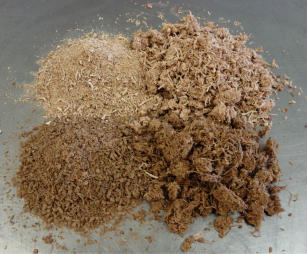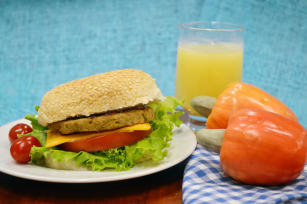Research develops solvent that facilitates reuse of plant waste
Research develops solvent that facilitates reuse of plant waste
Researchers have successfully tested a new alternative that can facilitate the use of cashew bagasse and other similar (lignocelullosic) materials in biorefineries. They were able to separate the components of the material using an ionic liquid that has offered advantages with regard to other types of reagents. The study can contribute to the exploitation of cellulose-rich agroindustrial waste.
The material used in the study is formed by lignin, cellulose and hemicellulose. Like all lignocelullosic materials, they require pre-treatment to separate cellulose from the remaining components. After such release, the cellulose can be broken into smaller sugars, which can then be used for the production of different molecules within the concept of biorefinaries. The main problem is that the pre-treatment of cashew bagasse thus far required drastic conditions such as high concentrations of reagents, high temperatures and high pressure.
The researchers then decided to test a kind of liquid salt as a solvent, technically known as protic ionic liquid, synthecized at the Federal University of Ceará (UFC). Embrapa's Multiuser Laboratory of Chemistry of Natural Products characterized the reagent and proved the results.
Reusable for up to three times
The samples that were treated presented much higher glucose yield than presented by most treatments that can be applied to cashew bagasse. With the advantage that the liquid can be reused at least three times, unlike the other reagents.
The researchers believe that the solvent can offer considerable environmental and economic benefits through the possibility of reuse - a hypothesis that still has to be assessed in further studies. The scientists responsible for the study also want to test the method with other lignocellulosic materials.
According to professor Maria Valderez Ponte Rocha, from UFC's Department of Chemical Engineering, it is possible to obtain from several carbohydrates of interest cashew bagasse cellulose and hemicellulose. One of them is xylose, from which xylitol is produced, which is an edulcorant with lower calorific value than sacarose and which is used as sweetener in children's toothpaste and other products.
Another possibility is using glucose to produce 2-phenilethanol, an aroma used by the perfume and food industries. Within the concept of biorefinary, another possibility to explore is lignin, which is abundant in the cashew bagasse. The material, which precipitates in the ionic liquid, can be used in the production of chemical intermediates and adsorbents (solids that retain molecules) or to generate energy from burning.
Economically viable product
The use of an ionic liquid in the pre-treatment of lignocellulosic material for the production of bioproducts used to be considered an unlikely hypothesis. That was due to the fact commercial versions of such reagents are usually expensive, which makes industrial applications impracticable.
The reagent used in the study is an ionic liquid that, at a laboratorial scale, is estimated to be 50 times cheaper than the similar ones available. The solvent was produced by UFC and, according to professor Valderez Ponte Rocha, synthesizing it is simple and involves low-cost precursor reagents and mild conditions. “It can easily be produced in an industrial environment”, he explains. The researchers in the future intend to conduct studies on the reagent's scaling-up and economic feasibility.
To prove the efficiency of the ionic liquid, Embrapa characterized the reagent, as well as the results of the processes. The researchers observed that it is chemically and thermally stable. “UFC was producing this liquid, but needed evidence of the formation of the organic liquid salt”, underscores the researcher Kirley Canuto, from Embrapa Tropical Agroindustry.
Canuto believes that the new solution can be tested to explore other lignocellulosic materials. For him, one of the greatest advantages of the method is the possibility of reusing the ionic liquid, which can reduce costs and impact on the environment.
Economic potential of the cashew bagasse
About 70% of the cashew peduncles produced in Brazil are still wasted due to the short harvest period, reduced post-harvest stability and the industry's small capacity of absorption. This is a lot, since this plant part, which is known as the cashew apple, corresponds to 90% of the fruit.
The cashew bagasse, which remains from the juice processing, has sugars, vitamins and minerals. It is rich in staple fibres and other compounds with functional properties, and is also a source of carotenoids and polyphenols. Countless possibilities in exploring the material are being studied at Embrapa Tropical Agroindustry.
Translation: Mariana Medeiros
Verônica Freire (MTb 01225/CE)
Embrapa Tropical Agroindustry
Press inquiries
agroindustria-tropical.imprensa@embrapa.br
Phone number: +55 85 3391.7116
Further information on the topic
Citizen Attention Service (SAC)
www.embrapa.br/contact-us/sac/


